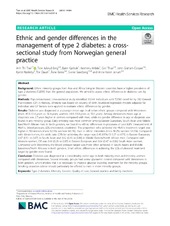| dc.contributor.author | Tran, Anh Thi | en_US |
| dc.contributor.author | Berg, Tore Julsrud | en_US |
| dc.contributor.author | Gjelsvik, Bjørn E. | en_US |
| dc.contributor.author | Mdala, Ibrahimu | en_US |
| dc.contributor.author | Thue, Geir | en_US |
| dc.contributor.author | Cooper, John Graham | en_US |
| dc.contributor.author | Nøkleby, Kjersti | en_US |
| dc.contributor.author | Claudi, Tor | en_US |
| dc.contributor.author | Bakke, Åsne | en_US |
| dc.contributor.author | Sandberg, Sverre | en_US |
| dc.contributor.author | Jenum, Anne Karen | en_US |
| dc.date.accessioned | 2020-08-05T12:21:57Z | |
| dc.date.available | 2020-08-05T12:21:57Z | |
| dc.date.issued | 2019-11-28 | |
| dc.Published | Tran AT, Berg TJ, Gjelsvik BE, Mdala I, Thue G, Cooper, Nøkleby K, Claudi T, Bakke Å, Sandberg S, Jenum AK. Ethnic and gender differences in the management of type 2 diabetes: a cross-sectional study from Norwegian general practice.. BMC Health Services Research. 2019;19:904 | eng |
| dc.identifier.issn | 1472-6963 | |
| dc.identifier.uri | https://hdl.handle.net/1956/23466 | |
| dc.description.abstract | Background: Ethnic minority groups from Asia and Africa living in Western countries have a higher prevalence of type 2 diabetes (T2DM) than the general population. We aimed to assess ethnic differences in diabetes care by gender. Methods: Population-based, cross-sectional study identified 10,161 individuals with T2DM cared for by 282 General Practitioners (GP) in Norway. Ethnicity was based on country of birth. Multilevel regression models adjusted for individual and GP factors were applied to evaluate ethnic differences by gender. Results: Diabetes was diagnosed at a younger mean age in all other ethnic groups compared with Westerners (men: 45.9–51.6 years vs. 56.4 years, women: 44.9–53.8 years vs. 59.1 years). Among Westerners mean age at diagnosis was 2.7 years higher in women compared with men, while no gender difference in age at diagnosis was found in any minority group. Daily smoking was most common among Eastern European, South Asian and Middle East/North African men. In both genders, we found no ethnic differences in processes of care (GPs’ measurement of HbA1c, blood pressure, LDL-cholesterol, creatinine). The proportion who achieved the HbA1c treatment target was higher in Westerners (men: 62.3%; women: 66.1%), than in ethnic minorities (men 48.2%; women 53.5%). Compared with Western men, the odds ratio (OR) for achieving the target was 0.45 (95% CI 0.27 to 0.73) in Eastern European; 0.67 (0.51 to 0.87) in South Asian and 0.62 (0.43 to 0.88) in Middle Eastern/North African men. Compared with Western women, OR was 0.49 (0.28 to 0.87) in Eastern European and 0.64 (0.47 to 0.86) South Asian women. Compared with Westerners, the blood pressure target was more often achieved in South Asians and Middle Easterners/North Africans in both genders. Small ethnic differences in achieving the LDL-cholesterol treatment target by gender were found. Conclusion: Diabetes was diagnosed at a considerably earlier age in both minority men and minority women compared with Westerners. Several minority groups had worse glycaemic control compared with Westerners in both genders, which implies that it is necessary to improve glucose lowering treatment for the minority groups. Smoking cessation advice should particularly be offered to men in most minority groups. | en_US |
| dc.language.iso | eng | eng |
| dc.publisher | BioMed Central | eng |
| dc.rights | Attribution CC BY | eng |
| dc.rights.uri | http://creativecommons.org/licenses/by/4.0/ | eng |
| dc.title | Ethnic and gender differences in the management of type 2 diabetes: a cross-sectional study from Norwegian general practice | en_US |
| dc.type | Peer reviewed | |
| dc.type | Journal article | |
| dc.date.updated | 2020-01-28T11:46:48Z | |
| dc.description.version | publishedVersion | en_US |
| dc.rights.holder | Copyright 2019 The Authors | |
| dc.identifier.doi | https://doi.org/10.1186/s12913-019-4557-4 | |
| dc.identifier.cristin | 1784044 | |
| dc.source.journal | BMC Health Services Research | |

